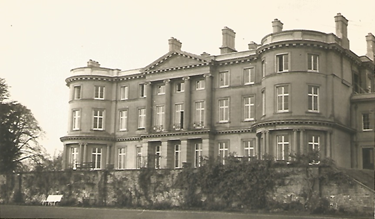The Revd. Moore Pye: A Cromwellian Soldier and Schoolmaster at Monmouth and Llanvapley by Jeremy Knight
The Revd. Moore Pye: A Cromwellian Soldier and Schoolmaster at Monmouth and Llanvapley by Jeremy Knight
In 1646, soon after Raglan Castle fell to
the Parliamentary army, an ex-soldier Revd Moore Pye , became Usher (Deputy
Headmaster ) of Monmouth School . The Pyes were a Herefordshire family, whose
head was the royalist Sir Walter Pye of Dewchurch. More Pye’s unusual Christian
name probably derived from a marriage alliance with another border family, the
puritan Moores of Bishop’s Castle in Shropshire, clients of the influential
parliamentarian Harleys of Brampton Bryan. Moore Pye had family connections
with Walford, between Monmouth and Hay on Wye.
He was a university graduate, one of a minority among parish clergy at
this date, though he does not appear in Alumni
Oxoniensis, an invaluable biographical guide to Oxford graduates, with
their places of origin. 1 . He probably held a curacy before the
outbreak of the Civil War, though the event may have interrupted his studies in
royalist Oxford. His
career during the early part of the war has not been traced, but he is known to
have served in the Parliamentary army in its later stages, perhaps as a
regimental chaplain. Like many Monmouthshire puritans, he may have moved to
Gloucester at the outbreak of war and served under his fellow Monmouthshire
man, Thomas Morgan ‘Little Sir Thomas Morgan, the great soldier’, later
commander of Gloucester garrison.
In February 1646, towards the end of the
war, local Glamorgan royalists led by Edward Carne of Ewenny and Sir Charles
Kemeys of Cefn Mably laid siege to Cardiff, then in the hands of a group of
hard line puritans. A parliamentary relief expedition routed the royalists in a
battle at the Heath, north of Cardiff. Moore Pye evidently distinguished himself
in the battle, for he was chosen to carry the dispatches to London,
traditionally a reward for an officer ‘mentioned in dispatches’ for gallant
service. Pye was rewarded by Parliament with a gift of £20. The relief force
was led by several Parliamentary commanders and though it is uncertain under
which of them Pye served it was most likely Sir Thomas Morgan. Morgan and Sir
Trevor Williams of Llangybi had combined forces the previous year to reduce
Chepstow and Monmouth for Parliament.
Three months later, Williams and Morgan
marched against Raglan Castle, the last remaining Royalist stronghold in south
Wales. On 30 May 1646 a pamphlet appeared in London giving a lively account of
the preliminaries of the siege. The
Gallant Siege of Parliament’s Forces before Ragland, Maintained by Colonel Morgan,
Major General Laughorn, Sir Trevor Williams, Baronet and Colonel Robert Kyrle… was
by ‘M.P’, almost certainly Moore Pye.
It was normal at
this date for regimental chaplains to serve as war correspondents. The author
is a participant in the siege, resident in Monmouth, able to drop Latin phrases
into his text and the style is very similar to Pye’s diary of the following
year. It may be significant that Thomas Morgan was given pride of place in the
list of commanders.
After the fall of Raglan, Pye was rewarded with the post of Usher at Monmouth School and in 1647 was living in Monmouth with his wife and family. In the early nineteenth century a copy of William Lilley’s almanac Merlini AnglicaeEphemeris was found in Monmouth. Pye had used it as a diary. Extracts were published by a local printer-historian and in 1859 a transcript of this ‘curious old pocket book’ appeared in The Monmouth Beacon. though the section from February to October was already missing and by the time it was reprinted in 1899 the book was lost. It paints a lively picture of post-war Monmouth, where an errant boarder from Monmouth School had to be reclaimed from ‘The Leaguer’- a civil war earthwork, where he had been drinking with ‘a gang of roughish boys’. There was the coming and going of troops and parliament had given orders that Monmouth was to be dis-garrisoned, the defences removed and the castle slighted. One December morning, the service in St Mary’s church was interrupted when ‘Ye Tower of ye castle fell down upon one side whilst we were at sermon’. This was the circular great tower, like those surviving at Tretower, Pembroke and elsewhere.
Like many Monmouthshire clergy at the time, Pye was harassed by the various committees set up by Parliament to reform religion in Wales. In 1649 he was appointed minister of Llanvapley between Abergavenny and Monmouth, by the Committee for Plundered Ministers (implying that he had held a pre-war curacy), only to be ejected by the Committee for the Propagation of the Gospel in Wales the following year.
In 1653 he became a
schoolmaster in Swansea before becoming vicar of Bishopston in Gower in 1655.
In March 1648 parliament had granted Cromwell much of the sequestrated estates
of the Earl of Worcester in Monmouthshire and Glamorgan, including Gower and
Swansea. Cromwell’s associate Colonel Philip Jones had been steward of Gower
and Governor of Swansea since 1645 and
played a major role in the administration of Cromwell’s Gower estates 2 Pye was one of the group of religious radicals
influential in Gower in the 1650s, though he unsuccessfully petitioned for
re-instatement to Llanvapley at the Restoration, He is not known to have been
one of the clergy expelled after the Restoration or in the ‘Bartholemew Day’
evictions of 1662, though a new preacher, Hopkin Thomas was appointed to
Bishopston in 1664 and a new vicar Grant Roberts two years later. In 1677 Moore
Pye was living in Woonton (probably Woonton Herefordshire rather than that near
Tewkesbury in Gloucestershire) and from then until 1726 his son and grandson,
both named Herbert Pye were vicars of Monmouth (Bradney, Hundred of Skenfrith 11)
1. J
Foster Alumni Oxoniensis, The Members of
the University of Oxford 1500-1714 (Oxford, 3 vols 1891-2).






